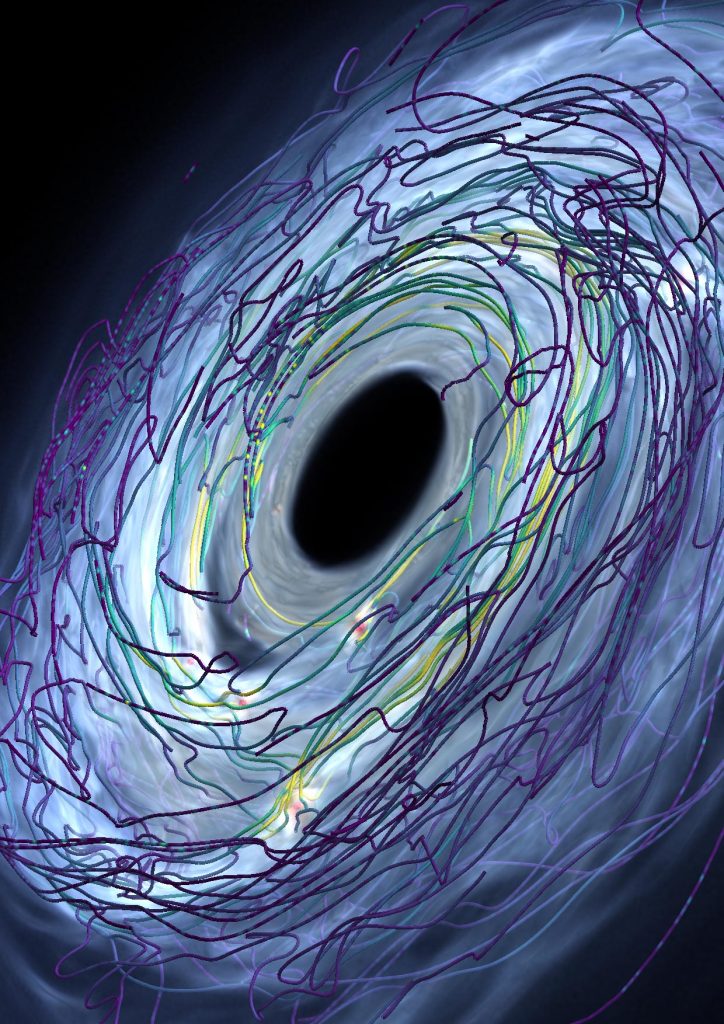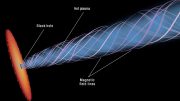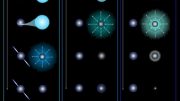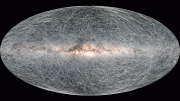In the last 25 years, scientists have discovered over 4000 planets beyond the borders of our solar system. From relatively small rock and water worlds to blisteringly hot gas giants, the planets display a remarkable variety. This variety is not unexpected. The sophisticated computer models, with which scientists study the formation of planets, also spawn very different planets. What the models have more difficulty to explain is the observed mass distribution of the planets discovered around other stars. The majority have fallen into the intermediate-mass category – planets with masses of several Earth masses to around that of Neptune. Even in the context of the solar system, the formation of Uranus and Neptune remains a mystery. Scientists of the Universities of Zurich and Cambridge, associated with the Swiss NCCR PlanetS, have now proposed an alternative explanation backed up by comprehensive simulations. Their results were published in the scientific journal Nature Astronomy.
Two contrasting forces…
“When planets form from the so-called protoplanetary disk of gas and dust, gravitational instabilities could be the driving mechanism,” Lucio Mayer, study co-author and Professor of Computational Astrophysics at the University of Zurich, and member of the NCCR PlanetS, explains. In this process, dust and gas in the disk clump together due to gravity and form dense spiral structures. These then grow into planetary building blocks and eventually planets.
The scale on which this process occurs is very large – spanning the scale of the protoplanetary disk. “But over shorter distances – the scale of single planets – another force dominates: That of magnetic fields developing alongside the planets,” Mayer elaborates. These magnetic fields stir up the gas and dust of the disk and thus influence the formation of the planets. “To get a complete picture of the planetary formation process, it is therefore important to not only simulate the large scale spiral structure in the disk. The small-scale magnetic fields around the growing planetary building blocks also have to be included,” says lead-author of the study, former doctoral student of Mayer and now Research Fellow at the University of Cambridge, Hongping Deng.
…that are difficult to grasp simultaneously
However, the differences in scale and nature of gravity and magnetism make the two forces very challenging to integrate into the same planetary formation model. So far, computer simulations that captured the effects of one of the forces well, usually did poorly with the other. To succeed, the team developed a new modeling technique. That required expertise in a number of different areas: First, they needed a deep theoretical understanding of both gravity and magnetism. Then, the researchers had to find a way to translate the understanding into a code that could efficiently compute these contrasting forces in unison. Finally, due to the immense number of necessary calculations, a powerful computer was required – like the “Piz Daint” at the Swiss National Supercomputing Centre (CSCS). “Apart from the theoretical insights and the technical tools that we developed, we were therefore also dependent on the advancement of computing power,” Lucio Mayer says.
A decades old puzzle solved?
Against the odds, everything came together at the right time and enabled a breakthrough. “With our model, we were able to show for the first time that the magnetic fields make it difficult for the growing planets to continue accumulating mass beyond a certain point. As a result, giant planets become rarer and intermediate-mass planets much more frequent – similar to what we observe in reality,” Hongping Deng explains.
“These results are only a first step, but they clearly show the importance of accounting for more physical processes in planet formation simulations. Our study helps to understand potential pathways to the formation of intermediate-mass planets that are very common in our galaxy. It also helps us understand the protoplanetary disks in general,” Ravit Helled, study co-author and Professor of Theoretical Astrophysics at the University of Zurich and member of the NCCR PlanetS, concludes.
Reference: “Formation of intermediate-mass planets via magnetically controlled disk fragmentation” by Hongping Deng, Lucio Mayer and Ravit Helled, 11 February 2021, Nature Astronomy.
DOI: 10.1038/s41550-020-01297-6










… But what if our Universe is just a petry dish universe to a very advanced civilization, that is spinning inside a black whole experimental universe, that has lower dimension in order to make it more easily observable spectacle…
There is absolutely not one shred of evidence for this in any observations of newly-formed stars. Zero. Zilch. this is speculative mathematic fantasy churned out by computers that have been fed with the right parameters to produce such imaginings. These parameters do not exist in nature- only in the minds of those who wish to spin a narrative.
Just take a look at star-forming regions for the evidence against this nonsense.
It is far more likely that planets form in much the same manner as stars do- in the dense clouds of gas and dust that are cast from supernovae. The processes may be identical with eleemtary richness, mass aglomeration, density and core nucleation being the variables between each entity.
?
First off, the model applies to star forming regions consisting of molecular clouds – whether generated by earlier massive stars or supernovas – so there is no problem of differing likelihood in that sense.
Second, what evidence is lacking? There is plenty of evidence for magnetic fields in the galaxy as well as in our own forming planetary system.
“The Milky Way galaxy has its own magnetic field. It’s extremely weak compared to Earth’s; thousands of times weaker, in fact. But astronomers want to know more about it because of what it can tell us about star formation, cosmic rays, and a host of other astrophysical processes.
A team of astronomers from Curtin University in Australia, and CSIRO (Commonwealth Scientific and Industrial Research Organization) have been studying the Milky Way’s magnetic field, and they’ve published the most comprehensive catalogue of measurements of the Milky Way’s magnetic field in 3D.”
“The galaxy’s magnetic field also plays a role in star formation. Though the effect is not fully understood, the strength of a magnetic field may affect molecular clouds. As Dr. Sobey told UT, “At smaller scales (on the order of parsecs), magnetic fields play a role in star formation, with too weak or strong a field in a molecular cloud possibly inhibiting the collapse of a cloud into a stellar system.””
[“This is the Milky Way’s Magnetic Field”, Universe Today]
“Observations of magnetic fields across multiple spatial scales toward both low-mass (Li et al., 2009; Hull et al., 2014) and high-mass (Zhang et al., 2014; Li et al., 2015) protostellar sources have also been used to constrain the dynamical importance of the magnetic field based on the morphological consistency (or lack thereof) of the field as a function of scale.”
[“Interferometric Observations of Magnetic Fields in Forming Stars”, Front. Astron. Space Sci., 05 March 2019]
“Earth and its planetary neighbors arose in a magnetic field strong enough to sculpt the disk of gas and dust that spawned our solar system and set the stage for a planet capable of developing life. That’s the implication of new work that uses a meteorite to deduce the strength of the magnetic field around the young sun.”
“David Wilner, an astronomer at the Harvard-Smithsonian Center for Astrophysics in Cambridge who was not involved with the study, calls the result amazing. “It’s really quite a remarkable measurement,” he says. “It’s notoriously difficult to measure anything about magnetic fields in protoplanetary disks.”
Was the ancient magnetic field just the right strength to mold the sun’s protoplanetary disk into a solar system containing a world of the right size at the right orbital distance to develop life? “I don’t think we understand the processes well enough to really make that connection directly,” Wilner says, “but it surely wouldn’t surprise me if there were differences” in the properties of the sun’s planets had the magnetic field been stronger or weaker.”
[“First measurement of the ancient solar system’s magnetic field”, Science 2014]
Post Grad looking for grant money…meh.
Troll looking for trolling … meh.
I am. That I am.
Notably, a dash of magnetic fields consistent with observations are also able to scaffold cosmological expansion rate measurements so that they all agree.
“Astronomers are discovering that magnetic fields permeate much of the cosmos. If these fields date back to the Big Bang, they could solve a major cosmological mystery” [“The Hidden Magnetic Universe Begins to Come Into View”, Quanta Magazine].
Here is another recent planetary system formation model consistent with some observations (of fast planet growth): https://advances.sciencemag.org/content/7/8/eabc0444 .
“Pebbles of millimeter sizes are abundant in protoplanetary discs around young stars. Chondrules inside primitive meteorites—formed by melting of dust aggregate pebbles or in impacts between planetesimals—have similar sizes. The role of pebble accretion for terrestrial planet formation is nevertheless unclear. Here, we present a model where inward-drifting pebbles feed the growth of terrestrial planets. The masses and orbits of Venus, Earth, Theia (which later collided with Earth to form the Moon), and Mars are all consistent with pebble accretion onto protoplanets that formed around Mars’ orbit and migrated to their final positions while growing. The isotopic compositions of Earth and Mars are matched qualitatively by accretion of two generations of pebbles, carrying distinct isotopic signatures. Last, we show that the water and carbon budget of Earth can be delivered by pebbles from the early generation before the gas envelope became hot enough to vaporize volatiles.”
Its like hitting your head against a brick wall. This BS standard model is a corpse that mainstream scientist? Wont let go. We live in a plasma universe. Electricity and magnetism run the show. Bo gas suns no gravitic ecretion BS. They arw now finding the gas and duat hiding all the matter they couldn’t see before cause them to make up BS like dark matter. This is more of the same and painful to read. That they made their model luckily line up with observation. Every new observation does add up with their stupid crap suck of it
Magnetic fields are created by the flow of electrical current, until the astronomical scientists go back to school and study Plasma science, they will continue to get it wrong every time.